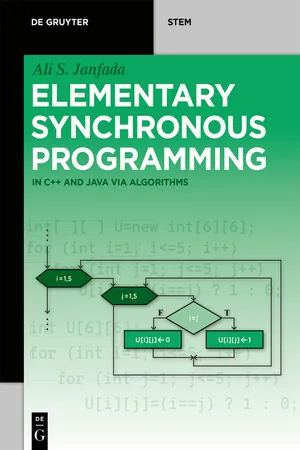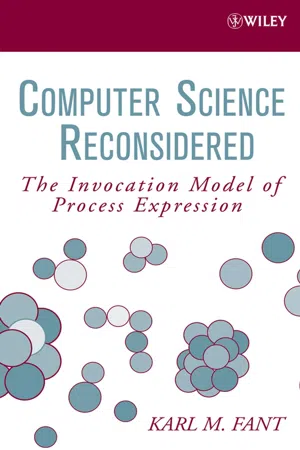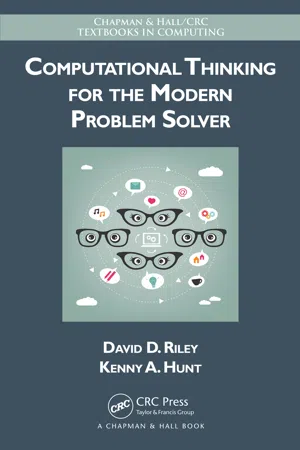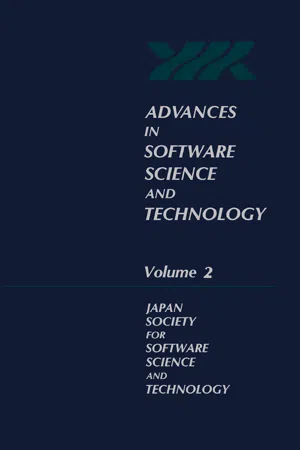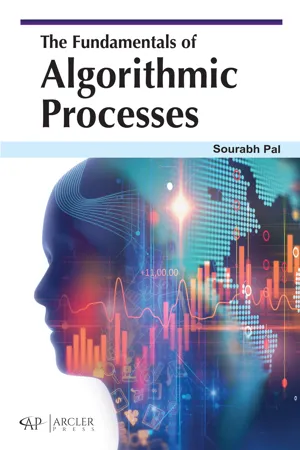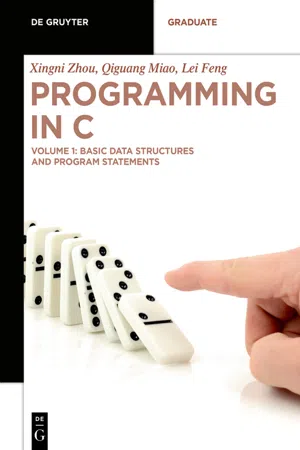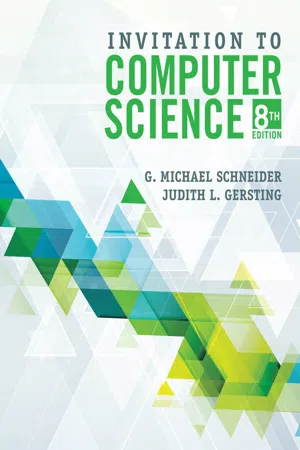Computer Science
Algorithm in C
"Algorithm in C" refers to the implementation of algorithms using the C programming language. C is a popular language for writing efficient and high-performance algorithms due to its low-level capabilities and close-to-hardware access. This involves writing code in C that follows a step-by-step procedure to solve a specific problem, making it a fundamental concept in computer science and programming.
Written by Perlego with AI-assistance
Related key terms
1 of 5
10 Key excerpts on "Algorithm in C"
- eBook - PDF
Elementary Synchronous Programming
in C++ and Java via algorithms
- Ali S. Janfada(Author)
- 2019(Publication Date)
- De Gruyter Oldenbourg(Publisher)
https://doi.org/10.1515/9783110616484-001 1 Basic concepts of Algorithm 1.1 Algorithm The word algorithm is derived from the name of a great Iranian Muslim mathemati-cian, astronomer, and philosopher named al-Khawrizmi 1 , who lived in the second century anno hegirae. In general, by an algorithm, a set of usually predefined and orderly instructions is meant to be followed to solve a particular type of problem. One may perform various kinds of algorithms without being aware of them, in their rou-tine and daily lives. For instance, the process of preparing a meal requires several instructions since different stages are needed in cooking and preparing it for serving. Take as another example, attending a church or mosque to say one’s praying. This ritual needs several processes which can be turned into an algorithm. The same ap-plies to robots. These machines are designed based on a special algorithm which in-cludes a set of instructions to implement them in a way that when such instructions are implemented successively, they move harmonically and perform the predesigned tasks accurately. Other instances could be constructing a building, driving a car, tak-ing medicine, setting the table, reading a book, taking a trip, publishing a book, di-recting an office, and many other types of activities. When a mathematical problem is suggested in a classroom, and the corresponding data are presented afterwards. Consequently, particular solutions are expected to be obtained. Accordingly, a prob-lem-solving algorithm is implemented 2 in order to arrive at specific results. Even the processes which follow in somebody’s mind during solving a problem in their per-sonal lives, some kinds of algorithms occur somewhat differently, for these algo-rithms are not predefined vividly. Having understood a problem, one could investigate various steps to approach the solution. That, in turn, requires several other phases to arrive at a certain finding to the posed problem. - eBook - PDF
Computer Science Reconsidered
The Invocation Model of Process Expression
- Karl M. Fant(Author)
- 2007(Publication Date)
- Wiley-Interscience(Publisher)
Computer science is primarily concerned with the nature of the expression of processes regardless of what particular process might be expressed: the nature of expression is considered independent of its process. There is much overlap between the interests of computer science and math- ematics, but the core concern with the nature of process expression itself is the unique conceptual focus that distinguishes computer science from the other sciences and from mathematics. Computer science is the science of process expression. 1.4 THE Algorithm in COMPUTER SCIENCE Introductory texts on computer science often begin with a chapter on the notion of the algorithm declaring it the fundamental paradigm of computer science. Conspicuously absent from these introductory chapters is discussion of how the notion contributes to the resolution of significant problems of computer science. In the remaining chapters of these texts there is typically no further appeal to the notion of the algorithm and rarely even a usage of the word itself. The notion is never or very rarely appealed to in texts on logic design, computer architecture, operating systems, programming, software engineering, programming languages, compilers, data structures, and data base systems. The notion of the algorithm is typically defined by simply presenting a list of properties that an expression must posses to qualify as an algorithm. The following definition of an algorithm is typical: 1. An algorithm must be a step-by-step sequence of operations. 2. Each operation must be precisely defined. 3. An algorithm must terminate in a finite number of steps. 4. An algorithm must effectively yield a correct solution. 5. An algorithm must be deterministic in that, given the same input, it will always yield the same solution. This is pretty much what Hilbert proposed in 1900, and it is easy to see how this list of restrictive characteristics serves to define what is acceptable as a mathematical solution. - eBook - PDF
- Rex Porbasas Flejoles(Author)
- 2019(Publication Date)
- Arcler Press(Publisher)
FUNDAMENTALS OF ALGORITHMS CHAPTER 1 CONTENTS 1.1. Introduction ........................................................................................ 2 1.2. Different Types of Problems Solved by Algorithms ............................... 4 1.3. Data Structures ................................................................................... 8 1.4. Algorithms as a Technology ................................................................. 9 1.5. Algorithms and Other Technologies .................................................. 11 1.6. Getting Started With Algorithm ......................................................... 13 1.7. Analyzing Algorithms ........................................................................ 18 References ............................................................................................... 25 Introduction To Algorithms 2 1.1. INTRODUCTION We define an algorithm as any well-defined computational method that takes input in the form of any value, or else set of values, and resultantly produces any value, or else set of values, as output. Hence, an algorithm is considered a sequence of computational steps which transforms any input into the output. Another way of seeing algorithm is to consider it as a tool that solves a well-specified computational problem (Aggarwal & Vitter, 1988; Agrawal et al., 2004). Generally, the statement of the problem postulates the desired relationship between input and output; whereas, the algorithm defines a particular computational process for achieving that relationship between input and output. For instance, suppose that we want to sort a sequence of numbers into an increasing order. This problem arises quite often in practice and makes available a fertile ground for presenting numerous standard design practices as well as analysis tools (Adel’son-Vel’skii & Landis, 1962; Abramowitz & Stegun, 1965). - David Riley, Kenny A. Hunt(Authors)
- 2014(Publication Date)
- Chapman and Hall/CRC(Publisher)
130 ◾ Computational Thinking for the Modern Problem Solver actions, and how to reduce complexity by decomposing large problems into smaller units. 5.1 ALGORITHMS An algorithm is a sequence of discrete actions that when followed, will result in achieving some goal or solving some problem. Everyone is accus-tomed to following algorithms in daily life whether we are aware of it or not. Football players are following an algorithm when they execute a play on the field; drivers are using an algorithm when they follow a set of instructions for getting from one city to another; piano players are using an algorithm when they read and play a musical score; mathematicians are using an algorithm when they use long division to find the ratio of two numbers; and actors are using an algorithm of sorts when they read and execute a script for some theatrical performance. As another example, consider that a recipe is an algorithm that a chef can follow to create a main dish, dessert, or even a drink. Chocolate Chip 1 Cookie Recipe Ingredients • 1 cup melted butter • 2 cups brown sugar • 2 eggs • 3 cups flour • 1 teaspoon baking powder • 1 teaspoon baking soda • 2 cups chocolate chips Directions 1. Preheat the oven to 375 degrees F. 2. Line a cookie sheet with parchment paper 3. In a bowl, stir together the butter, brown sugar and eggs. 4. In a separate bowl, combine the flour, baking powder and baking soda. Gradually combine with the sugar mixture. 5. Add the chocolate chips 6. Fill the cookie sheet with one-spoonful drops of the cookie dough. 7. Bake dough for 9 minutes 8. Cool for five minutes before removing from cookie sheet. Image courtesy of http://www.flickr.com/photos/amagill/34754258/ In the field of computer science, an algorithm is any well-defined sequence of actions that takes a set of values as input and produces some set of values as output. In other words, an algorithm is a sequence of com-putational actions that transform the input into the desired output. A- eBook - ePub
C Programming
Learn to Code
- Sisir Kumar Jena(Author)
- 2021(Publication Date)
- Chapman and Hall/CRC(Publisher)
Section 3.5 will introduce the concept of programming and the different components involved in executing them.3.3 Algorithm Design
Before we jump into the definition of an algorithm, let us look at the image shown in Figure 3.3 . We have taken this image from a cook book by Sanjeev Kapoor. The objective of using this image is to introduce you to different features of an algorithm. We are not here to learn cooking; instead, the picture will help you to understand how to write unambiguous statements in making a recipe. The procedure written in the image has a high resemblance to algorithm design.Figure 3.3 A cooking recipe.If you analyze the recipe, you can easily see that the steps are well written, and whoever follows the steps will able to cook a tasty “crisp pohe”. No actions are ambiguous, and the procedure mentions all the ingredients required to prepare the recipe. We can say that the method specified in the image is a step-by-step method to make the food, and the ingredients are known as the input for processing. Finally, the “crisp pohe” will be the output of this process.Now we are ready to explain the algorithm. By following the similar analogy discussed above, we can define an algorithm as follows:An algorithm is a sequence of unambiguous instructions for solving a problem in a finite amount of time.According to the programmer’s perspective, we write the algorithm to solve a given programming task that can easily be converted into a program statement irrespective of any programming language. For example, let the job be to add two numbers; then how do we write an algorithm for that? Following the problem-solving technique, we need to analyze and identify the input to our algorithm and what should be the output produced by it. In our case, the algorithm needs two numbers, and it will provide their addition as the result. After that, we need to write the step-by-step procedure to perform the addition operation. Every step must instruct the computer to do something, and upon completion of all the steps, the machine should produce the required result. The complete algorithm to solve the addition of two numbers will be discussed in the subsequent section. - eBook - PDF
- Yoshio Ohno, Hiroyasu Kakuda, Tsutomu Kamimura(Authors)
- 2014(Publication Date)
- Academic Press(Publisher)
Just as physics has exerted an influence on mathematical concepts, so computer science is today beginning to affect them. This trend is particularly evident in the field of algorithms. In this article, we consider the history of algorithms in society and culture. 1 Formation of the Concept of Algorithm in the History of Math-ematics Loosely speaking, algorithms are procedures for reaching a goal of some kind. How-ever, the range of areas in which algorithms are used, and indeed, the contents and nature of the algorithms themselves, are extremely diverse. Copyright © 1991 by Academic Press, Inc. and 1 7 7 Iwanami Shoten, Publishers. All rights of reproduction in any form reserved. ISBN 0-12-037102-2 178 Advances in Software Science and Technology 2, 1990 Algorithms appear in a variety of contexts: as means of obtaining numerical values or function values, as techniques for judging the truth or falsehood of certain types of proposition, and as methods for winning at certain games. Where numer-ical values are computed, a method of computation — an algorithm — is always involved. It seems useful to distinguish between the discovery and simple execution of the procedure for performing calculations on the one hand, and an awareness of algorithms on the other. By awareness we mean the realization that if opera-tions or manipulations are performed according to the algorithm, the desired result will be obtained. It would seem that such an awareness appeared only long after algorithms themselves. While it is difficult to distinguish clearly between the two, if one could find examples of algorithms devised out of curiosity, not prompted by practical considerations, for studying the behavior of problems and solutions, this would constitute evidence that by that time at the latest, algorithms themselves had become objects of investigation. - eBook - PDF
- Sourabh Pal(Author)
- 2023(Publication Date)
- Arcler Press(Publisher)
A proper algorithm solves the stated computing issue. An erroneous algorithm, on either side, cannot halt at all on certain input examples, or it can halt with an inaccurate response (Ahuja et al., 1989; Courcoubetis et al., 1992). In contrast to our assumptions, erroneous algorithms may occasionally be advantageous if the rate of mistake may be Fundamentals of Algorithms 3 controlled. Therefore, we shall only be concerned with accurate algorithms (Figure 1.1) (Szymanski and Van Wyk, 1983; King, 1995; Didier, 2009). Figure 1.1. Algorithms’ basic structure and overview. Source: http://openclassroom.stanford.edu/MainFolder/CoursePage. php?course=IntroToAlgorithms. An algorithm may be written in English, in the format of a computer program, or even as a hardware design. The only criterion is that the problem definition must include a clear description of the computational procedure to be used (Snyder, 1984). The following are the features of an algorithm: • Each instruction should take an indefinite amount of time to complete; • Almost every instruction should be explicit and accurate, that is, each instruction must have just one meaning; • The consumer must get the expected outcomes after following the directions; • There must be no unlimited repeating of a single or several instructions, implying that the algorithm must eventually finish. 1.2. VARIOUS TYPES OF ISSUES SOLVED BY ALGORITHMS Scientists have devised algorithms for a variety of computer problems, including sorting. Algorithms have a broad range of practical usage across the world. The following are certain such instances: • The Human Genome Project are made tremendous progress in recent years toward the goal of classifying all 100,000 genes The Fundamentals of Algorithmic Processes 4 found in the DNA of humans, specifying the sequences of the 3 billion chemical base pairs that make up human DNA, storing this massive amount of information in databases, and developing data analysis techniques. - No longer available |Learn more
- Gary Bronson(Author)
- 2012(Publication Date)
- Cengage Learning EMEA(Publisher)
Instead, you must give the computer a detailed, step-by-step set of instructions that col-lectively form an algorithm. For example, the following set of instructions forms a detailed method, or algorithm, for determining the sum of the numbers from 1 through 100: Set n equal to 100 Set a = 1 Set b equal to 100 Calculate sum = n(a + b)/2 Print the sum These instructions are not a computer program. Unlike a program, which must be written in a language the computer can respond to, an algorithm can be written or described in various ways. When English-like phrases are used to describe the steps in an algorithm, as in this example, the description is called pseudocode . When mathematical equations are used, the description is called a formula . When diagrams with the symbols shown in Figure 1.7 are used, the description is referred to as a flowchart . Figure 1.8 shows using these symbols to depict an algorithm for determining the average of three numbers. Copyright 2012 Cengage Learning. All Rights Reserved. May not be copied, scanned, or duplicated, in whole or in part. Due to electronic rights, some third party content may be suppressed from the eBook and/or eChapter(s). Editorial review has deemed that any suppressed content does not materially affect the overall learning experience. Cengage Learning reserves the right to remove additional content at any time if subsequent rights restrictions require it. - eBook - PDF
- Xingni Zhou, Qiguang Miao, Lei Feng(Authors)
- 2020(Publication Date)
- De Gruyter(Publisher)
2 Algorithms Main contents – Concept of algorithms – Representation of algorithms – Effectiveness of algorithms – Universality of algorithms – Comprehensiveness of algorithms Learning objectives – Know concepts related to algorithms – Know the characteristics of computer algorithms – Know representations of algorithms – Know general procedures of algorithm design – Can design algorithms in top-down stepwise refinement method Donald Ervin Knuth once said, “ Programs are like blue poems. ” If that is true, then algorithms are the soul of these poems. 2.1 Concept of algorithms 2.1.1 Algorithms in practice Let us take a look at a real-life algorithm: ticket purchasing at the ticket office. When there was no internet, Mr. Brown had to buy train tickets at ticket offices when he needed to take business trips. The main procedures of purchasing tickets are shown in Figure 2.1, in which the key information includes the date, destination, train number, price, and fare. In fact, everything is done under certain conditions and through performing a se-ries of operations. Algorithms are methods and procedures used to solve the problems. Nowadays, Mr. Brown can purchase tickets easily online. The main steps of online pur-chasing are shown in Figure 2.2. Compared with offline purchasing, online purchasing uses the same set of crucial information, except that we are dealing with computer sys-tems instead of a human. Step 1: The passenger provides information on trip date, destination, etc. Step 2: The staff finds trains available on that day Step 3: The passenger chooses a train and determines number of tickets to buy Step 4: The passenger pays the fare and collects tickets Algorithms are methods and procedures used to solve problems. Case Study 1 Purchasing tickets through ticket office Figure 2.1: Flow of purchasing tickets at the ticket office. https://doi.org/10.1515/9783110692327-002 - eBook - PDF
- G.Michael Schneider, Judith Gersting(Authors)
- 2018(Publication Date)
- Cengage Learning EMEA(Publisher)
Our introduction used ex-amples drawn from everyday life, such as programming a DVR (Figure 1.1) and washing your hair (Figures 1.3 and 1.4). Although these are perfectly valid ex-amples of algorithms, they are not of much interest to computer scientists. This chapter develops more fully the notions of algorithms and algorithmic problem solving and applies these ideas to problems that are of interest to computer scientists: searching lists, finding maxima and minima, and matching patterns. 2.2 Representing Algorithms 2.2.1 Pseudocode Before presenting any algorithms, we must first make an important decision. How should we represent them? What notation should we use to express our algorithms so that they are clear, precise, and unambiguous? One possibility is natural language , the language we speak and write in our everyday lives. (This could be English, Spanish, Arabic, Japanese, Swahili, Algorithm Discovery and Design 2 Copyright 2019 Cengage Learning. All Rights Reserved. May not be copied, scanned, or duplicated, in whole or in part. Due to electronic rights, some third party content may be suppressed from the eBook and/or eChapter(s). Editorial review has deemed that any suppressed content does not materially affect the overall learning experience. Cengage Learning reserves the right to remove additional content at any time if subsequent rights restrictions require it. 45 or any language.) This is an obvious choice because it is the language with which we are most familiar. If we use natural language, then our algorithms would read much the same as a term paper or an essay. For example, when expressed in natural language, the addition algorithm in Figure 1.2 might look something like the paragraph shown in Figure 2.1. Comparing Figure 1.2 with Figure 2.1 illustrates the problems of using natural language to represent algorithms. Natural language can be extremely verbose, causing the resulting algorithms to be rambling, unstructured, and hard to follow.
Index pages curate the most relevant extracts from our library of academic textbooks. They’ve been created using an in-house natural language model (NLM), each adding context and meaning to key research topics.
